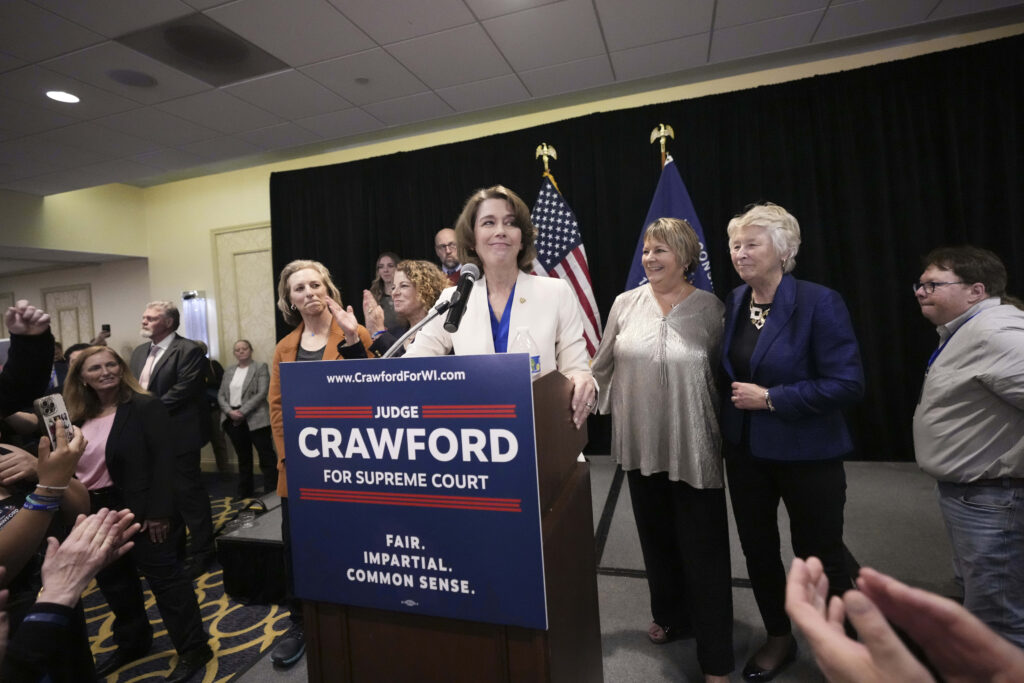Why Wisconsin’s Election Result Is a Win for Democracy

Susan Crawford, a liberal backed by Democrats, won the election for a seat on the Wisconsin Supreme Court Tuesday, defeating conservative judge Brad Schimel, who had the backing of President Donald Trump, billionaire Elon Musk and the full weight of the GOP.
Crawford’s win means the state’s highest court will remain a 4-3 liberal majority.
“Today, Wisconsinites fended off an unprecedented attack on our democracy, our fair elections and our Supreme Court,” Crawford said at a campaign event after the race was called. “And Wisconsin stood up and said, loudly, that justice does not have a price. Our courts are not for sale.”
The contentious election was the most expensive judicial election in U.S. history, with over $90 million spent supporting the two candidates. More than $50 million was spent to help Schimel, mostly from billionaire right-wing megadonors like Elon Musk and Richard and Elizabeth Uihlein.
A Musk-backed PAC even launched a campaign to pay voters who signed a petition opposing “activist judges” and took photos of Wisconsin residents posing with a Schimel picture outside of polling places. The weekend before the election, Musk traveled to Wisconsin and awarded several $1 million prizes to voters who signed the anti-Crawford petition — a move that Wisconsin Attorney General Josh Kaul charged violated state campaign finance laws, but Wisconsin’s courts refused to take up the case.
At the heart of why this state Supreme Court race became such a big deal is simple: partisan power to determine the future of voting rights and fair elections.
Wisconsin has been at the center of some of the most contentious voting rights and redistricting battles in recent years. In 2022, the state Supreme Court’s conservative majority blocked the use of drop boxes, only for the Court to reverse that decision in 2024 when ideological control flipped from conservative to liberal.
In December 2023, the Court’s liberal majority struck down state legislative maps drawn by GOP lawmakers as a partisan gerrymander. With Crawford’s victory, it’s unlikely any GOP challenge to the state’s legislative maps would be successful.
With Wisconsin’s new legislative maps, Democratic lawmakers flipped 14 seats in the state legislature in 2024, with the GOP holding on to a slim majority. After Crawford’s win, State Democrats are hoping to flip the legislature in the next state election cycle.
Democrats also hope the court could redraw the state’s congressional map, potentially handing them two more seats and giving Wisconsinites fairer representation.
“Votes are more powerful than dollars. This election was a battle between Musk Money and democracy, and today’s victory is a testament to the real power of the people,” former U.S. Attorney General Eric Holder, who serves as chairman of the National Democratic Redistricting Committee, said in a statement. “When Republicans — and the billionaires they are beholden to — tried to buy an extreme right-wing majority on Wisconsin’s highest court to act as a ‘support network’ for Trump, Wisconsinites said hell no.”
Restrictive voter ID requirement enshrined, a loss for democracy
Wisconsin voters also approved a ballot measure to enshrine the state’s restrictive voter ID requirement into the state constitution. Wisconsin lawmakers passed a voter ID requirement in 2011, which only allows certain types of IDs to be used for voting — limiting common forms like student IDs. The law faced a litany of legal challenges that were ultimately unsuccessful and went into effect in 2016.
With voters enshrining the voter ID law into the state constitution, it will be a lot harder for lawmakers to reverse it — they could do so only by passing another constitutional amendment.
The measure’s passage also could embolden other states to advance restrictive ID rules.
On his TruthSocial social media platform, Trump made no mention of Crawford’s victory but praised the results of the voter ID referendum. “Democrats fought hard against this, presumably so they can cheat,” he wrote. “This is a big win for Republicans, maybe the biggest win of the night. It should allow us to win Wisconsin, like I just did in the presidential election, for many years to come!”
After the voter ID law took effect in 2016, it greatly impacted voter turnout — particularly among voters of color — according to a post-election study. With the law enshrined into the state’s constitution, voting rights advocates in Wisconsin worry it will further disenfranchise tens of thousands of voters.
“Enshrining a voter ID mandate into the Wisconsin Constitution will guarantee the continued exclusion of many voters from the ballot box in future elections,” All Voting is Local Wisconsin State Director Sam Liebert said in a statement. “Seniors, people of color, people with disabilities, and people from low-income households are among the Wisconsinites who have difficulties obtaining an active form of ID and will be effectively disenfranchised by this mandate.”